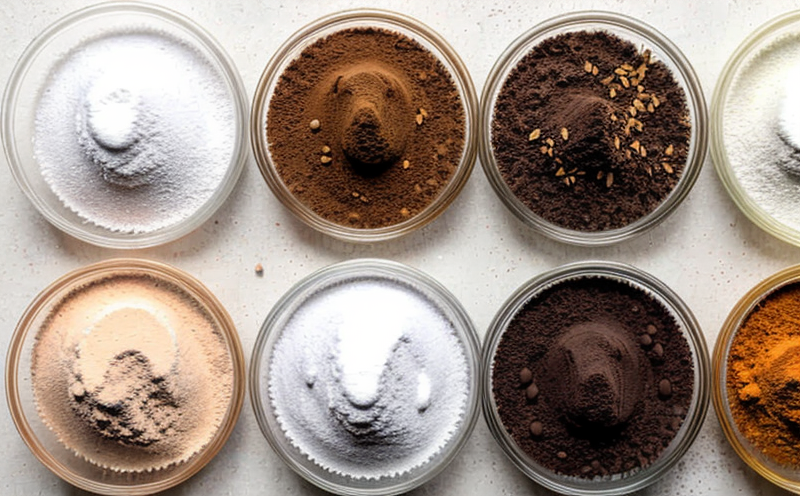ISO 20569 Tartrazine Detection in Beverages
The use of tartrazine (FD&C Yellow No. 5) as a colorant in beverages is subject to strict regulations globally, primarily due to its potential allergenic effects and the need for transparency regarding food additives. ISO 20569 provides guidelines for the safety assessment of food additives, including tartrazine, ensuring that products meet stringent quality standards before reaching consumers.
Our service specializes in detecting tartrazine residues in beverages using advanced analytical techniques compliant with ISO 20569. This process ensures that our clients can maintain compliance and ensure the safety of their products. The detection method involves several steps, including sample preparation, analysis, and interpretation of results.
Sample preparation is critical for accurate testing. Beverages are filtered to remove particulates, then diluted as necessary before undergoing chromatographic analysis. Chromatography is chosen for its precision in separating components of the beverage, allowing for the accurate identification and quantification of tartrazine. The method used adheres strictly to ISO 20569 standards.
The analytical process involves using a high-performance liquid chromatograph (HPLC) equipped with an ultraviolet-visible detector. This equipment is calibrated according to international standards, ensuring consistent results across multiple samples. Calibration ensures that the instrument can accurately measure tartrazine concentrations down to parts per million levels.
Once the sample has been analyzed, the results are interpreted against ISO 20569 guidelines. The acceptable limit for tartrazine in beverages is set at a concentration lower than 10 ppm by weight, as specified in ISO standards. Any detection above this level indicates potential non-compliance with regulatory requirements and necessitates corrective action.
The service also provides comprehensive reports detailing the testing process, including sample preparation, chromatographic data, and interpretation of results against ISO guidelines. These reports are invaluable for quality managers and compliance officers in ensuring that products meet all necessary safety standards.
Our expertise extends beyond simple detection; we offer advice on formulation adjustments to reduce tartrazine content if required by regulatory bodies or market demands. This service ensures that our clients stay ahead of changing regulations while maintaining product quality and safety.
Scope and Methodology
| Step | Description |
|---|---|
| Sample Preparation | Beverages are filtered to remove particulates, then diluted as necessary for chromatographic analysis. |
| Analytical Technique | High-performance liquid chromatography (HPLC) with an ultraviolet-visible detector is used for accurate measurement of tartrazine residues. |
| Calibration | The HPLC equipment is calibrated according to ISO 20569 standards, ensuring consistent results across multiple samples. |
| Interpretation of Results | The results are interpreted against the acceptable limit for tartrazine in beverages set at a concentration lower than 10 ppm by weight per ISO guidelines. |
Why Choose This Test
Selecting our service ensures that you comply with international standards for food additive safety, specifically targeting tartrazine in beverages. Compliance is crucial to prevent potential legal issues and maintain consumer trust. Our method provides accurate detection down to parts per million levels, ensuring no residue exceeds acceptable limits.
Our comprehensive reports provide detailed insights into the testing process, making them invaluable for internal audits and external compliance checks. This transparency can help build stronger relationships with regulatory bodies and customers alike.
We also offer tailored advice on formulation adjustments to reduce tartrazine content if required by regulatory bodies or market demands. This proactive approach ensures that your products stay compliant with current regulations while maintaining product quality.
Our expertise in this area allows us to provide valuable insights into the latest trends and requirements, helping you stay ahead of changes in the industry. With our service, you can ensure not only compliance but also a competitive edge in the market.
Environmental and Sustainability Contributions
The detection of tartrazine residues plays an important role in environmental sustainability by ensuring that products comply with strict regulatory requirements. By accurately detecting and reducing tartrazine content, we contribute to a cleaner environment and safer consumer products.
Our service supports the reduction of waste generated by non-compliant products, as it allows for early identification and correction of issues. This proactive approach helps minimize environmental impact associated with product recalls or disposal of non-compliant goods.
The use of advanced analytical techniques not only ensures compliance but also reduces unnecessary resource consumption in the production process. By detecting tartrazine residues accurately, we help clients optimize their manufacturing processes and reduce waste, aligning with broader sustainability goals.





